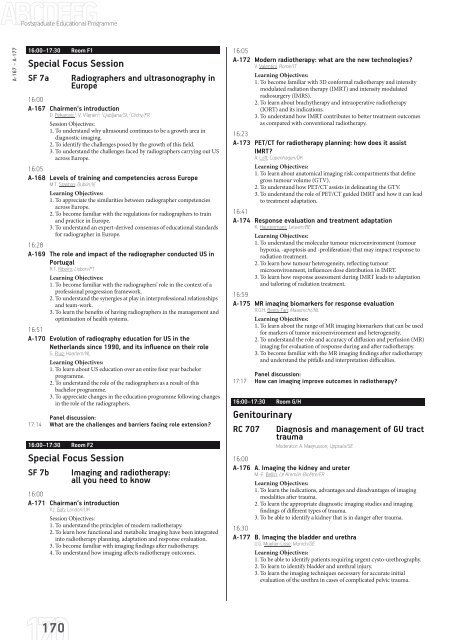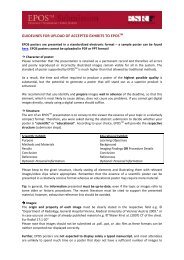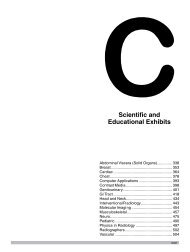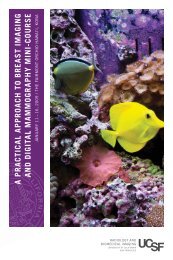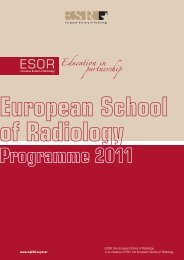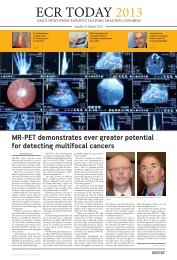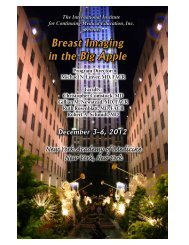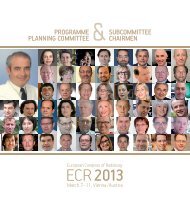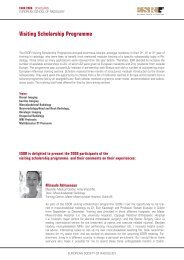ECR 2013 â Final Programme - myESR.org
ECR 2013 â Final Programme - myESR.org
ECR 2013 â Final Programme - myESR.org
- No tags were found...
You also want an ePaper? Increase the reach of your titles
YUMPU automatically turns print PDFs into web optimized ePapers that Google loves.
Postgraduate Educational <strong>Programme</strong>A-167 – A-17716:00–17:30 Room F1Special Focus SessionSF 7a Radiographers and ultrasonography inEurope16:00A-167 Chairmen‘s introductionD. Pekarovic 1 , V. Vilgrain 2 ; 1 Ljubljana/SI, 2 Clichy/FRSession Objectives:1. To understand why ultrasound continues to be a growth area indiagnostic imaging.2. To identify the challenges posed by the growth of this field.3. To understand the challenges faced by radiographers carrying out USacross Europe.16:05A-168 Levels of training and competencies across EuropeM.T. Stanton; Dublin/IELearning Objectives:1. To appreciate the similarities between radiographer competenciesacross Europe.2. To become familiar with the regulations for radiographers to trainand practice in Europe.3. To understand an expert-derived consensus of educational standardsfor radiographer in Europe.16:28A-169 The role and impact of the radiographer conducted US inPortugalR.T. Ribeiro; Lisbon/PTLearning Objectives:1. To become familiar with the radiographers’ role in the context of aprofessional progression framework.2. To understand the synergies at play in interprofessional relationshipsand team-work.3. To learn the benefits of having radiographers in the management andoptimisation of health systems.16:51A-170 Evolution of radiography education for US in theNetherlands since 1990, and its influence on their roleG. Plug; Haarlem/NLLearning Objectives:1. To learn about US education over an entire four year bachelorprogramme.2. To understand the role of the radiographers as a result of thisbachelor programme.3. To appreciate changes in the education programme following changesin the role of the radiographers.Panel discussion:17:14 What are the challenges and barriers facing role extension?16:00–17:30 Room F2Special Focus SessionSF 7b Imaging and radiotherapy:all you need to know16:00A-171 Chairman‘s introductionV.J. Goh; London/UKSession Objectives:1. To understand the principles of modern radiotherapy.2. To learn how functional and metabolic imaging have been integratedinto radiotherapy planning, adaptation and response evaluation.3. To become familiar with imaging findings after radiotherapy.4. To understand how imaging affects radiotherapy outcomes.16:05A-172 Modern radiotherapy: what are the new technologies?V. Valentini; Rome/ITLearning Objectives:1. To become familiar with 3D conformal radiotherapy and intensitymodulated radiation therapy (IMRT) and intensity modulatedradiosurgery (IMRS).2. To learn about brachytherapy and intraoperative radiotherapy(IORT) and its indications.3. To understand how IMRT contributes to better treatment outcomesas compared with conventional radiotherapy.16:23A-173 PET/CT for radiotherapy planning: how does it assistIMRT?A. Loft; Copenhagen/DKLearning Objectives:1. To learn about anatomical imaging risk compartments that definegross tumour volume (GTV).2. To understand how PET/CT assists in delineating the GTV.3. To understand the role of PET/CT guided IMRT and how it can leadto treatment adaptation.16:41A-174 Response evaluation and treatment adaptationK. Haustermans; Leuven/BELearning Objectives:1. To understand the molecular tumour microenvironment (tumourhypoxia, -apoptosis and -proliferation) that may impact response toradiation treatment.2. To learn how tumour heterogeneity, reflecting tumourmicroenvironment, influences dose distribution in IMRT.3. To learn how response assessment during IMRT leads to adaptationand tailoring of radiation treatment.16:59A-175 MR imaging biomarkers for response evaluationR.G.H. Beets-Tan; Maastricht/NLLearning Objectives:1. To learn about the range of MR imaging biomarkers that can be usedfor markers of tumor microenvironment and heterogeneity.2. To understand the role and accuracy of diffusion and perfusion (MR)imaging for evaluation of response during and after radiotherapy.3. To become familiar with the MR imaging findings after radiotherapyand understand the pitfalls and interpretation difficulties.Panel discussion:17:17 How can imaging improve outcomes in radiotherapy?16:00–17:30 Room G/HGenitourinaryRC 707 Diagnosis and management of GU tracttraumaModerator: A. Magnusson; Uppsala/SE16:00A-176 A. Imaging the kidney and ureterM.-F. Bellin; Le Kremlin-Bicêtre/FRLearning Objectives:1. To learn the indications, advantages and disadvantages of imagingmodalities after trauma.2. To learn the appropriate diagnostic imaging studies and imagingfindings of different types of trauma.3. To be able to identify a kidney that is in danger after trauma.16:30A-177 B. Imaging the bladder and urethraU.G. Mueller-Lisse; Munich/DELearning Objectives:1. To be able to identify patients requiring urgent cysto-urethrography.2. To learn to identify bladder and urethral injury.3. To learn the imaging techniques necessary for accurate initialevaluation of the urethra in cases of complicated pelvic trauma.170


